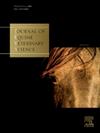毛发皮质醇浓度与马人格评估的关系
IF 1.6
3区 农林科学
Q2 VETERINARY SCIENCES
引用次数: 0
摘要
了解马的性格有助于改进对马的管理。马的性格评估(EPT)包括4个主要的性格因素:焦虑性、可训练性、亲和性和入口性。这个工具使用1到9的刻度。在6个问题中,1表示马表现出相反的特征(例如,冷静),5表示中性,9表示特征完全存在(例如,紧张)。其他13个问题决定了一个特征出现的频率,1表示很少,9表示经常。许多性格评估都以马的压力为特征。皮质醇浓度是一种压力的定量测量,它沉积在马的全身,几乎在所有组织中都能检测到。毛发皮质醇浓度(HCC)允许对平均皮质醇进行长期评估。由于人格是一种持续的特征,分析HCC提供了两种工具之间的比较。本研究的目的是评估EPT结果与HCC之间的潜在关系。假设焦虑人格特质与HCC直接相关,可训练性和亲和力人格因素与HCC负相关。该大学马研究中心的7名工作人员对一项改进的EPT进行了回应,该EPT分析了32匹大学马的3个性格因素:焦虑、可训练性和亲和力。工作人员评估与他们有2次或2次以上持续至少5分钟的互动的马。互动范围从一般的操作到骑马,但需要是一对一的。基于此,并不是每个学生都会评估每匹马。于2024年春季和秋季学期采集马尾毛(1.0 g)。样品被分成0.5 g的子样品,并根据先前发表的方法提取。采用SAS的一般线性模型和混合模型进行分析,评估人格特质对HCC的影响。员工焦虑、可训练性和亲和力的平均评分分别为4.49±0.91、6.19±1.20和6.13±1.00。对数转化后的HCC总均值为2.71±0.21 pg/mg。人格特征与HCC无显著性差异(P≥0.50)。这些发现表明HCC与EPT的人格特征无关。本研究仅评估了许多马人格评估工具中的一种,结果不应推断到其他工具,因为这可能不能准确地代表潜在的人格评估与hcc的关系。本文章由计算机程序翻译,如有差异,请以英文原文为准。
Relationship between hair cortisol concentrations and equine personality assessment
Understanding a horse's personality may allow for improved management of the animal. The equine personality assessment (EPT) includes 4 main personality factors: anxiety, trainability, affability, and gate entrance. This tool uses a 1 to 9 scale. For 6 questions, 1 indicates a horse presenting the opposite of a trait (e.g., calm), 5 is neutral, and 9 indicates a trait is fully present (e.g., nervous). The other 13 questions determine the frequency of a trait's presence, with 1 indicating rarely and 9 indicating often. Many personality assessments characterize horse stress. Cortisol concentration, a quantitative measure of stress, is deposited throughout an equine body and is detectable in almost all tissues. Hair cortisol concentration (HCC) allows a long-term assessment of average cortisol. As personality is an ongoing characteristic, analyzing HCC provides a comparison between the 2 tools. The objective of this study was to evaluate potential relationships between EPT results and HCC. It was hypothesized that the personality trait of anxiety would directly correlate to HCC and that personality factors of trainability and affability would be inversely related. Seven workers at the university's Equine Center responded to a modified EPT, which analyzed 32 university horses for 3 personality factors: anxiety, trainability, and affability. Workers evaluated horses with which they had had 2 or more interactions lasting at least 5 min. Interactions ranged from general handling to riding but needed to be one-on-one. Based on this, not every student evaluated every horse. Equine tail hair (1.0 g) was collected in the 2024 Spring and Fall semesters. Samples were split into 0.5 g subsamples and extracted based on previously published methods. Analysis was performed using SAS's General Linear Model and Mixed Model, evaluating the effect of personality traits on HCC. Mean worker assessment scores for anxiety, trainability, and affability scores were 4.49 ± 0.91, 6.19 ± 1.20, and 6.13 ± 1.00, respectively. Log-transformed overall mean HCC was 2.71 ± 0.21 pg/mg. There were no significant differences between personality traits and HCC (P ≥ 0.50). These findings suggest that HCC is not associated with personality traits using the EPT. This study only evaluated one of many equine personality assessment tools, and results should not be extrapolated to other instruments as this may not accurately represent potential personality assessments-HCC relationships.
求助全文
通过发布文献求助,成功后即可免费获取论文全文。
去求助
来源期刊

Journal of Equine Veterinary Science
农林科学-兽医学
CiteScore
2.70
自引率
7.70%
发文量
249
审稿时长
77 days
期刊介绍:
Journal of Equine Veterinary Science (JEVS) is an international publication designed for the practicing equine veterinarian, equine researcher, and other equine health care specialist. Published monthly, each issue of JEVS includes original research, reviews, case reports, short communications, and clinical techniques from leaders in the equine veterinary field, covering such topics as laminitis, reproduction, infectious disease, parasitology, behavior, podology, internal medicine, surgery and nutrition.
 求助内容:
求助内容: 应助结果提醒方式:
应助结果提醒方式:


